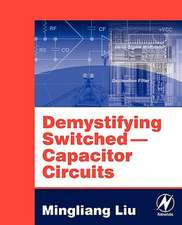Quantifying and Exploring the Gap Between FPGAs and ASICs
Autor Ian Kuon, Jonathan Roseen Limba Engleză Paperback – 3 sep 2014
| Toate formatele și edițiile | Preț | Express |
|---|---|---|
| Paperback (1) | 635.31 lei 6-8 săpt. | |
| Springer Us – 3 sep 2014 | 635.31 lei 6-8 săpt. | |
| Hardback (1) | 641.53 lei 6-8 săpt. | |
| Springer Us – 5 oct 2009 | 641.53 lei 6-8 săpt. |
Preț: 635.31 lei
Preț vechi: 747.43 lei
-15% Nou
Puncte Express: 953
Preț estimativ în valută:
121.58€ • 125.60$ • 101.19£
121.58€ • 125.60$ • 101.19£
Carte tipărită la comandă
Livrare economică 25 martie-08 aprilie
Preluare comenzi: 021 569.72.76
Specificații
ISBN-13: 9781489985095
ISBN-10: 1489985093
Pagini: 192
Ilustrații: XI, 180 p.
Dimensiuni: 155 x 235 x 10 mm
Greutate: 0.28 kg
Ediția:2010
Editura: Springer Us
Colecția Springer
Locul publicării:New York, NY, United States
ISBN-10: 1489985093
Pagini: 192
Ilustrații: XI, 180 p.
Dimensiuni: 155 x 235 x 10 mm
Greutate: 0.28 kg
Ediția:2010
Editura: Springer Us
Colecția Springer
Locul publicării:New York, NY, United States
Public țintă
ResearchCuprins
Background.- Measuring the Gap.- Automated Transistor Sizing for FPGAs.- Navigating the Gap Using Architecture and Process Technology Scaling.- Navigating the Gap using Transistor Sizing.- Conclusions and FutureWork.
Textul de pe ultima copertă
Field-Programmable Gate Arrays (FPGAs) have become the dominant digital implementation medium as measured by design starts. They are preferred because designers can avoid the pitfalls of nanoelectronic design and because the designer can change the design up until the last minute. However, it has always been understood that FPGAs use more area, are slower, and consume far more power than the alternative: Application-Specific ICs built from standard cells. But how much? Quantifying and Exploring the Gap Between FPGAs and ASICs is the first book to explore exactly what that difference is, to enable system designers to make better in-formed choices between these two media and to give insight to FPGA makers on the deficiencies to attack and thereby improve FPGAs. The gap is a very nuanced thing, though: it strongly depends on the nature of the circuit being implemented, in sometimes counterintuitive ways. The book presents a careful exploration of these issues in its first half. The second half of the book looks at ways that creators and users of FPGAs can close the gap between FPGAs and ASICs. It presents the most sweeping exploration of FPGA architecture and circuit design ever performed. The authors show that, with careful use of transistor-level design, combined with good choices of the soft-logic architecture, that a wide spectrum of FPGA devices can be used to narrow specific selected gaps in area, speed and power.
Caracteristici
Provides readers with a better appreciation of the gap between FPGAs and ASICs and a deeper understanding of FPGA architecture Corrects common misconceptions about the magnitude of the gap between FPGAs and ASICs and the benefits of FPGA features such as multipliers and memories Conveys the broad range of trade-offs that are possible in the design of FPGAs. In particular, the significant impact of transistor sizing on a FPGA’s efficiency and performance will be highlighted Addresses that lack of information regarding the ASIC or FPGA design choice










